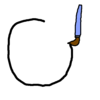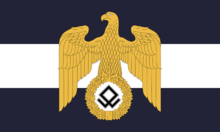 |
Work in Progress "I'll be done any day now!" - Still-Being-Drawnism This page is not done yet and may still contain inaccurate information or miss important details. |
Folk Socialism is an AuthUnity, economically ![]() far-left, culturally
far-left, culturally ![]() right-wing, and often labeled as fascist or proto-fascist populist ideology.
right-wing, and often labeled as fascist or proto-fascist populist ideology.
Furthermore, Folk Socialism is often corporatist, aiming for a form of corporatist socialism.
History
 Germany
Germany
 Conservative Revolution
Conservative Revolution
The Conservative Revolution (German: Konservative Revolution), also known as the German neoconservative movement, or new nationalism, was a German national-conservative movement prominent during the Weimar Republic and Austria, in the years 1918–1933 (between World War I and the Nazi seizure of power).
Conservative Revolutionaries were involved in a cultural counter-revolution and showed a wide range of diverging positions concerning the nature of the institutions Germany had to instate, labelled by historian Roger Woods the "conservative dilemma". Nonetheless, they were generally opposed to traditional Wilhelmine Christian conservatism, egalitarianism, liberalism and parliamentarian democracy as well as the cultural spirit of the bourgeoisie and modernity. Plunged into what historian Fritz Stern has named a deep "cultural despair", uprooted as they felt within the rationalism and scientism of the modern world, theorists of the Conservative Revolution drew inspiration from various elements of the 19th century, including Friedrich Nietzsche's contempt for Christian ethics, democracy and egalitarianism; the anti-modern and anti-rationalist tendencies of German Romanticism; the vision of an organic and naturally-organized folk community cultivated by the Völkisch movement; the Prussian tradition of militaristic and authoritarian nationalism; and their own experience of comradeship and irrational violence on the front lines of World War I.
The Conservative Revolution held an ambiguous relationship with Nazism from the 1920s to the early 1930s, which has led scholars to describe it as a form of "German pre-fascism", or "non-Nazi fascism". Although they share common roots in 19th-century anti-Enlightenment ideologies, the disparate movement cannot be easily confused with Nazism. Conservative Revolutionaries were not necessarily racialist as the movement cannot be reduced to its Völkisch component. Although they participated in preparing the German society to the rule of the Nazi Party with their antidemocratic and organicist theories, and did not really oppose their rise to power, Conservative Revolutionary writings did not have a decisive influence on Nazism, and the movement was brought to heel like the rest of the society when Adolf Hitler seized power in 1933, culminating in the assassination of prominent thinker Edgar Jung by the Nazis during the Night of the Long Knives in the following year. Many of them eventually rejected the antisemitic or the totalitarian nature of the Nazi regime, with the notable exception of Carl Schmitt and some others.
From the 1960–1970s onwards, the Conservative Revolution has largely influenced the European New Right, in particular the French Nouvelle Droite and the German Neue Rechte, and through them the contemporary European Identitarian movement.
Beliefs
Folk Socialism is economically far-left and culturally right-wing, although some theorists of Folk Socialism were ![]() corporatist, such as
corporatist, such as ![]() Oswald Spengler. However, Folk Socialism is not corporatist, as corporatists are a faction within Folk Socialism.
Oswald Spengler. However, Folk Socialism is not corporatist, as corporatists are a faction within Folk Socialism.
Folk Socialism, in its view, is a national socialism that supports ![]() traditionalism,
traditionalism, ![]() nationalism,
nationalism, ![]() socialism, and corporatism, making it a syncretic ideology.
socialism, and corporatism, making it a syncretic ideology.
It is similar to the ![]() Völkisch movement and has its origins there, although obviously without the racism and ethnonationalism.
Völkisch movement and has its origins there, although obviously without the racism and ethnonationalism.
In the social realm, Folk Socialism embraces traditionalism, which serves as the foundation of its ideology.
How to Draw

- Draw a sphere with two horizontal blue-gray lines.
- Draw a golden Reichsadler with an Odal rune (ᛟ).
- (Optional) Add a black/gray helmet with the emblem of the German eagle facing left and a golden spike.
- You're done.
| Color Name | HEX | RGB | |
|---|---|---|---|
| Gray Blue | #222336 | 34, 35, 54 | |
| White | #FFFFFF | 255, 255, 255 | |
| Black | #141414 | 20, 20, 20 | |
| Golden | #ecbc46 | 236, 188, 70 | |